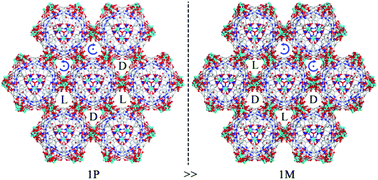Selective chiral symmetry breaking and luminescence sensing of a Zn(ii) metal–organic framework†
Abstract
The chiral Zn(II) metal–organic framework [(CH3)2NH2]5[Zn1.5(Zn3O)(TATAT)2]·9DMF·17H2O (1) has been prepared from achiral precursors Zn(NO3)2·6H2O and 5,5′,5′′-(1,3,5-triazine-2,4,6-triyl)tris(azanediyl)triisophthalate (H6TATAT) in a solvent mixture of DMF/MeOH/H2O/HCOOH without any chiral sources. In particular, the non-random handedness excess (1P ≫ 1M) was generated and was verified by single-crystal X-ray diffraction and solid-state circular dichroism spectroscopy. Furthermore, complex 1 displays high selectivity and sensitivity for detecting Fe3+ and is found to be an excellent chemical sensor for detecting nitro explosives especially 3-nitrophenol.



 Please wait while we load your content...
Please wait while we load your content...